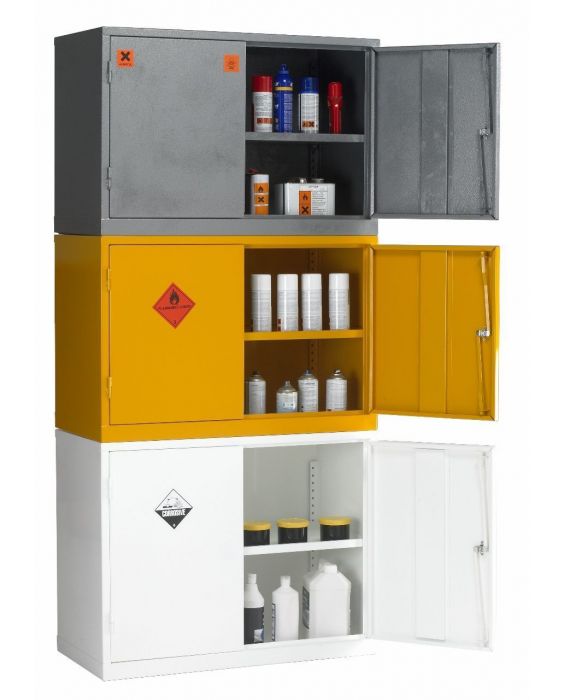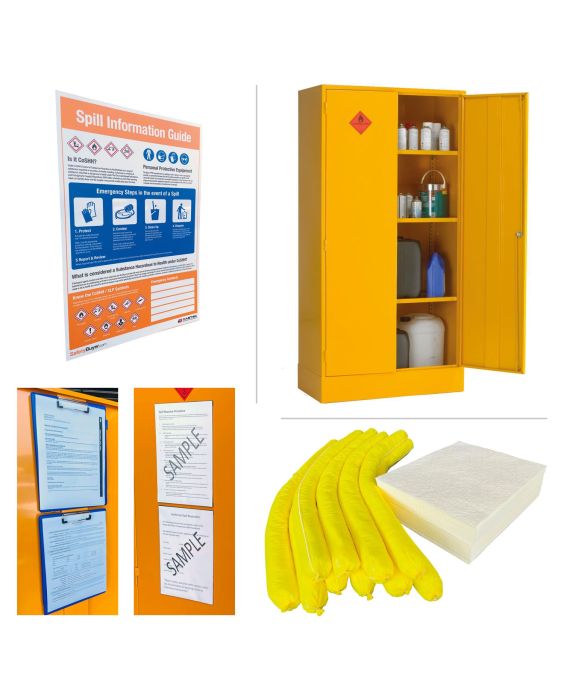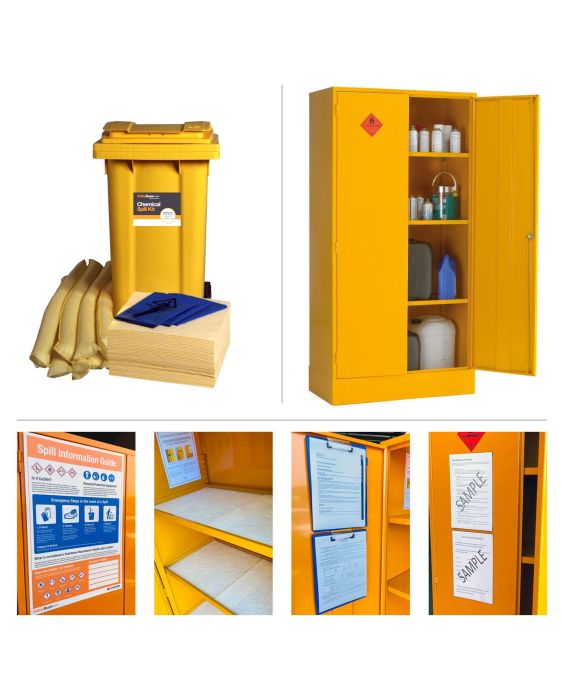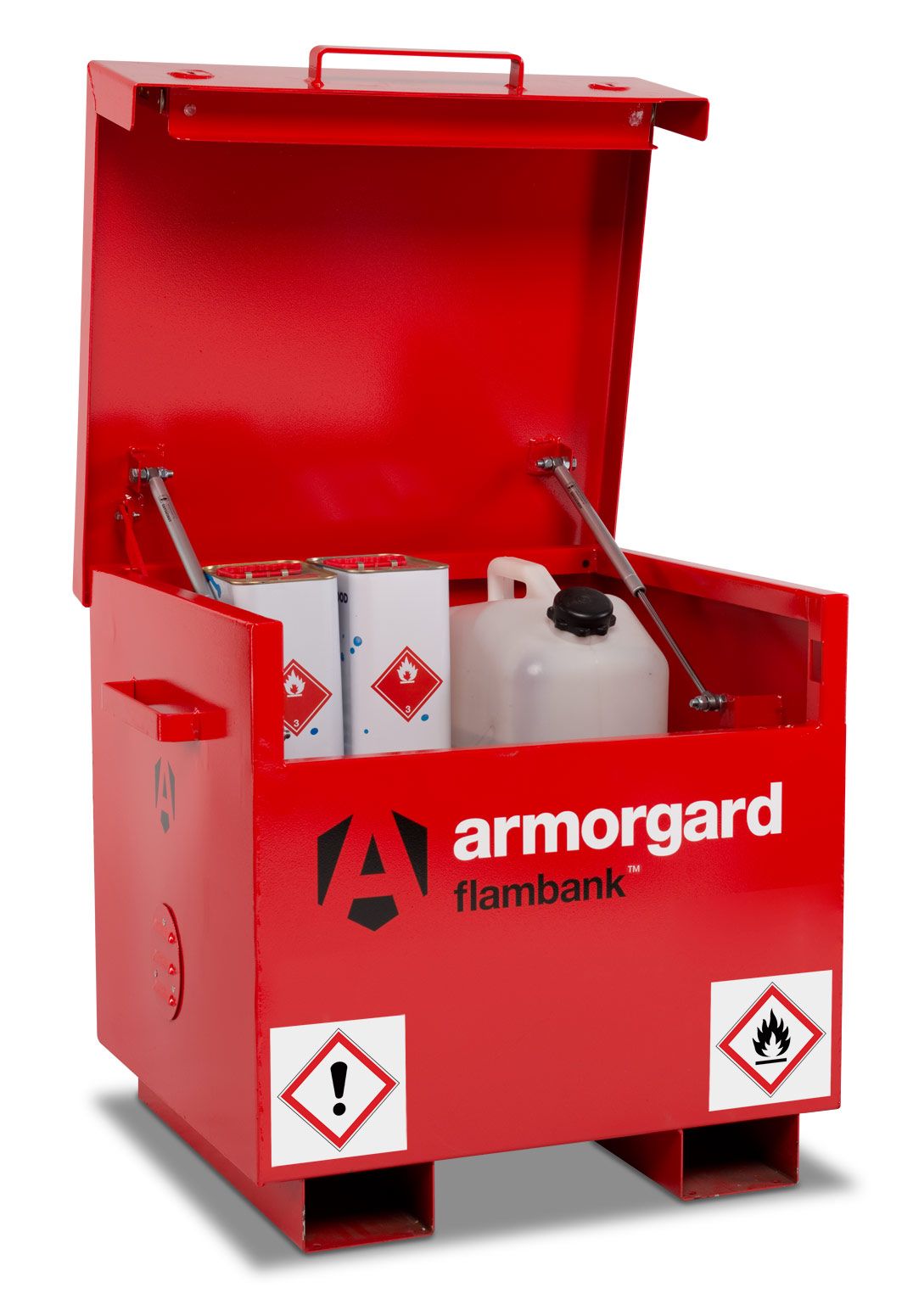Hazardous Substance Storage Cabinets
-

Starting at £179.99 £149.99
-

Starting at £215.99 £179.99
-
 From £347.99 £289.99
From £347.99 £289.99 -
 From £33.59 £27.99
From £33.59 £27.99 -
 £442.80 £369.00
£442.80 £369.00 -
 £466.80 £389.00
£466.80 £389.00 -
 £478.80 £399.00
£478.80 £399.00 -
 £574.80 £479.00
£574.80 £479.00 -
 From £119.99 £99.99
From £119.99 £99.99
You've completed a risk assessment for substances hazardous to health on-site and found that you need to buy a COSHH / Flammable Cabinet. You head to the internet to buy something that's readily available, from a reputable store and priced competitively – after all, that's the power of the internet, right?
Not so fast. Your Google search will return a plethora of results, but these hazardous storage cabinets are NOT all the same - find out more below.
Watch our video to find the right hazardous storage cabinet for you
One important feature of hazardous storage cabinets to highlight is the cabinet base or sump. When shopping for a product of this type, we would encourage you to take a closer look at this detail.
If your workplace requires yellow hazardous substance storage cabinets for the safety of your staff, SafetyBuyer has you covered. We sell a range of durable storage cabinets that are suitable for hazardous and flammable substances, and deliver protection, value for money and peace of mind.
Browse our complete range of hazardous substance storage cabinets below. To find out more about our range of cabinets, download our PDF guide.
We encourage you to watch this video on hazardous cabinets to help you to visualise the various types of storage cabinets for substances hazardous to health and understand how they differ from each other.
If you have any questions, call us for free on 0800 043 0161, or email us at sales@safetybuyer.com.
What to look out for in hazardous storage cabinets
Simply put, if the base of the cabinet isn't fully leak-proof, then an accidental spillage inside the cabinet is at risk of ending up on your workshop floor. This could be a health and safety hazard, so you should take due diligence in choosing a cabinet that works for your workspace.
Cabinets are usually described as having a ‘sump capacity', which is the amount of liquid it should safely retain in its base in the event of a spill. The sump is typically located at the bottom of the cabinet and is designed to catch and contain any spills or leaks from the substances stored within the cabinet.
In many jurisdictions, there are specific regulations governing the minimum sump capacity of such cabinets. For example, in the UK, COSHH regulations require that a sump should be capable of retaining at least 110% of the largest container stored within, or 25% of the total liquid storage capacity of the cabinet, whichever is greater. This is to ensure that the cabinet can effectively contain a potential spill, thus minimizing the risk of harmful substances contaminating the surrounding environment or causing harm to people.
Properly maintained sump capacities are a key factor in promoting safety and reducing the risks associated with the storage of hazardous substances. In addition to adhering to minimum capacity regulations, best practices also include regularly inspecting and cleaning the sump to ensure its integrity and functionality.
In the event that a shelf is overloaded or that a poorly-sealed container of substances hazardous to health is put away in the cabinet, a spillage can occur inside. COSHH cabinets differ in specifications, and importantly, in their ability to control the spillage of hazardous substances. Not all cabinets have fully sealed interiors, safely containing any hazardous substances that could leak or spill inside - many have removable sumps to catch spills, but these can allow dangerous liquids to escape the cabinet or pose a risk of liquids being spilled over an employee who may be tempted to remove a part-filled sump.
Our video shows you some of the different designs you can find online and will help you decide which model of cabinet will best satisfy the needs of your risk assessment and application.
With so many similar-looking cabinets available online and even more businesses recognising the need for COSHH-compliant cabinet, our aim is to encourage buyers to look more closely at the advertised descriptions, select the right cabinet and then inspect the product on delivery to make sure it will do what it's supposed to do.
Why you should do your research on hazardous substance storage
Having the right hazardous substance storage cabinet can help reduce the risk of accidents when working with dangerous materials, and minimise risks to worker health if there is ever a spill or leak in the workplace. It can also help improve safety compliance by ensuring all workers know where hazardous substances are located at all times. Finally, having an appropriate storage cabinet gives the peace of mind that comes with knowing your workplace has taken the right steps to ensure everyone's health and safety while working with potentially hazardous substances.
Manufactured in the UK, our hazardous and flammable substance storage cabinets are suitable for a wide range of potentially volatile materials. They are also built to last, and will help your company to stay compliant with health and safety regulations for years to come.
What are the benefits of hazardous storage cabinets?
If your workplace regularly makes use of hazardous or flammable materials, you have an important legal responsibility to store these substances safely and appropriately. This means investing in storage solutions for your business that are up to this challenging task. At SafetyBuyer, our UK-manufactured hazardous substance cabinets are built to deliver the very best quality, durability and reliability for your workplace, while also being cost-effective and fully compliant with all relevant standards.
Here are just a few of the benefits our cabinets can provide:
- Manufactured using 0.9mm and 1.2mm mild steel, delivering clear advantages in terms of product performance and longevity
- High melting point (above 750°C), with a 30-minute fire-resisting performance that conforms to the BS476 (Parts 20 & 22) standard
- Fully compliant with the Flammable Liquids & LPG Regulation 1972, HSG51 and DSEAR
- All joints and seams are fully welded - not simply folded - and finished with a high-grade epoxy-polyester powder coating process for excellent durability
- Sealed shelves are adjustable in 25mm increments and designed to act as spill trays for minor spillages
Find the perfect storage for your hazardous substances today
Our range of hazardous substance cabinets offers impressive value without compromising on product quality or safety compliance. You can find out more about the benefits of these cabinets by downloading our PDF guide, or checking out our video above. To find the right product for your needs, filter your search by size and type above, and buy with confidence. If you have any questions about these products, give us a call for free on 0800 043 0161, or drop us an email at sales@safetybuyer.com.FAQs about hazardous substance cabinets
What are the hazardous substances covered by COSHH regulations?
The Control of Substances Hazardous to Health (COSHH) regulations cover a wide range of substances including chemicals, products containing chemicals, fumes, dusts, vapours, mists, nanotechnology, gases and asphyxiating gases, and biological agents.
What is considered a hazardous substance?
A hazardous substance is any material that, due to its chemical nature, poses a potential risk to health, safety, or the environment. This includes:
- chemicals
- products containing chemicals
- fumes
- dusts
- vapours
- mists
- nanotechnology
- gases and asphyxiating gases and
- biological agents (germs). If the packaging has any of the hazard symbols then it is classed as a hazardous substance.
- germs that cause diseases such as leptospirosis or legionnaires disease and germs used in laboratories
Why should hazardous substances be stored in cabinets?
Cabinets designed for hazardous substance storage provide a controlled environment that minimises the risk of spills, leaks, or reactions. They protect the substances from physical damage, reduce the risk of accidental exposure to workers, and can help prevent the release of harmful substances into the environment.
What are the benefits of storing hazardous substances in dedicated cabinets?
Dedicated cabinets provide improved safety through features like fire resistance, spill containment, and secure locks. They help to organise substances properly, aid in inventory management, reduce the risk of cross-contamination, and ensure compliance with safety regulations.
What regulations or standards govern the storage of hazardous substances?
In addition to COSHH, other key regulations include the Dangerous Substances and Explosive Atmospheres Regulations (DSEAR), Health and Safety at Work Act, and Environmental Protection Act. Standards like BS EN 14470-1 and BS 476 pertain specifically to storage cabinets for flammable liquids.
How do I determine which type of cabinet is suitable for storing specific hazardous substances?
This depends on the nature of the substance. Refer to the substance's Safety Data Sheet (SDS) for specific storage requirements. Cabinets may need to meet standards for flammability, corrosion resistance, or other specific hazards.
Can I store different types of hazardous substances in the same cabinet?
Certain hazardous substances should not be stored together due to risks of reactions. Refer to the SDS and guidance from health and safety authorities to understand which substances can be safely stored together.
Are there any specific labelling requirements for hazardous substance storage cabinets?
Yes, cabinets should be labelled with the appropriate hazard symbols and should include information about the type and quantity of substances stored.
How should I organise and categorise hazardous substances within the cabinet?
Substances should be grouped by their hazard classification, and incompatible substances should be segregated. Regularly used items should be easily accessible.
Are there any special considerations for storing flammable liquids in cabinets?
Cabinets for flammable liquids should be fire-resistant and include features like self-closing doors and spill containment.
Are there restrictions on the quantity of hazardous substances that can be stored in a cabinet?
Yes, local regulations may limit the quantity of certain substances that can be stored in a single location. These limits depend on factors like the hazard classification of the substance and the safety features of the storage area.
How should I handle spills or leaks within a hazardous substance storage cabinet?
Use appropriate PPE and cleanup materials as specified by the substance's SDS. Cabinets should have built-in spill containment features to help manage leaks.
What safety features should I look for in a hazardous substance storage cabinet?
Key safety features include fire resistance, spill containment, secure locks, robust construction, and appropriate hazard labelling. Take a look at our video to understand the differences between various hazardous substance cabinets to find the perfect one for you. Get in touch with our team if you have any queries.
Can I use a regular storage cabinet for storing hazardous substances?
Regular storage cabinets are typically not suitable as they lack the necessary safety features such as fire resistance and spill containment.
How often should I inspect and maintain hazardous substance storage cabinets?
Regular inspections should be carried out at least annually, with maintenance or replacements as needed. However, more frequent inspections may be necessary depending on the substances stored and the specific requirements of your safety management system.
Can I modify a cabinet to better suit my needs for storing hazardous substances?
Any modifications must not compromise the safety features of the cabinet and should comply with relevant regulations and standards. It's advisable to consult with a safety professional before making any modifications.
Are there specific ventilation requirements for hazardous substance storage cabinets?
Some substances may require ventilation. However, ventilation can also increase risks, such as the spread of fumes. The need for ventilation should be determined based on a risk assessment and the substance's SDS.
Can I store hazardous substances in a cabinet located outdoors?
Outdoor storage may be acceptable if the cabinet is designed for outdoor use and provides adequate protection against weather and temperature variations. Additional security measures may be required to prevent unauthorised access.
What precautions should I take when storing corrosive or reactive substances in cabinets?
Cabinets for corrosive substances should be resistant to corrosion, and segregated storage may be necessary for reactive substances. Appropriate PPE should be used when handling these substances.
How do I dispose of expired or unused hazardous substances stored in a cabinet?
Refer to the substance's SDS for disposal guidance. Disposal must comply with local environmental and waste disposal regulations. Specialised waste disposal services may be needed.
Can I use a general waste disposal bin for disposing of waste from the hazardous substance storage cabinet?
No, hazardous waste should not be disposed of in general waste bins. It must be disposed of in accordance with local regulations, which may require the use of specialised waste disposal services.
What are the requirements for a corrosive cabinet?
A corrosive cabinet must be built from or lined with materials that resist corrosion. It should have features like spill containment, and doors that close automatically or can be securely latched.
 Over 12,000
Over 12,000  Simple no quibble
Simple no quibble  Prompt dispatch &
Prompt dispatch &  UK Mainland Delivery
UK Mainland Delivery 
















